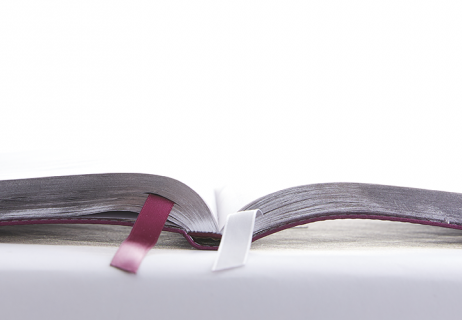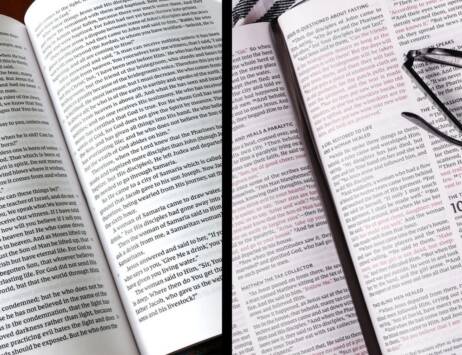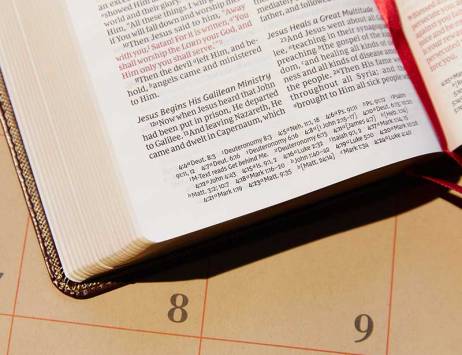Study Bibles are great tools for study and personal growth. They can help lead you closer to God and they can help you impact the lives of those around you. With this in mind, it’s important to choose the right study Bible for your needs. There are a lot of options available and many of them focus on different things. In this article, we’ll look at the different features to help you choose the best study Bible for you.
What is a Study Bible?
A study Bible provides tools to aid in Bible study. They go beyond the typical reference Bible tools: cross-references, a concordance, and maps. Study Bibles add tools such as commentary on the text, a topical index, character studies, word studies, articles, book introductions, in-text maps and charts, explanations about theology, and more.
They tell us about the people, culture, and events, and include biblical teachings from pastors and Bible scholars. They provide facts and insights that would take weeks or years to glean from the text or would require lots of external resources to study from.
Every study Bible has a specific purpose or theme. While some provide general information, others go deeper into a specific type of information. Popular themes include teens, women, fathers, leaders, students, etc.
Study Bibles are a great choice for finding answers to difficult passages and getting help in sermon or lesson preparation. They provide concise information that’s easy to access, understand, and use.
Study Bibles don’t replace the vast amount of tools in a library, but they do condense the number of tools you need to have on hand. They can help save you money by reducing the number of resources you need.
1. Determine its Purpose
No one study Bible is perfect for every person and every use. The first step is to decide how you will use it. This will help you decide the types of tools you’ll need. Common uses include personal study, sermon prep, teaching classes, leading a small group, writing devotionals, school work, and leadership.
2. Decide the Features You Need
Features vary between study Bibles, but typical features include:
Topical Index – a detailed index that covers all of the major topics and subtopics of Scripture.
Introductions – detailed information about the author, the occasion of writing, date of writing, key characters, key verses, key themes, outlines, and more. They tend to focus on the topics that the study Bible is designed for. There are two types. The first introduces the major types of books, such as the Pentateuch, wisdom literature, history, epistles, etc. The second introduces specific books of the Bible and go into more detail about that book.
Articles – detailed articles cover many topics including the focus point of that specific study Bible, theology, etc. They can be placed throughout the text, in the front or back, or between the testaments.
Maps – in-text maps provide a detailed look at the locations mentioned on or around the page they’re found on. These are in addition to the standard maps in the back of the Bible.
Charts – Charts show timelines of events, lists of people, places, topics, etc. They show information such as the names of the kings of Judah, when they were king, what events took place, which books took place at the same time, etc.
Study Notes – these are usually placed at the bottom of the page and include commentary on the text, word studies, and insights into the culture, information about people and places, and application. They often include facts, history, explanations, theology, and application.
Color photos – full-color photos of places, artifacts, archaeological sites, and artwork are often placed on the pages with the text, within book introductions, and within articles.
Concordance – many Bibles have a concordance, but those in study Bibles are usually much larger. They provide lots more entries and references and include other information such as biographical studies, topics, and definitions.
3. Choose Your Translation
Choose a translation based on your preferred reading level or translation philosophy. Here are the main options.
Literal (formal equivalence) translations focus on the actual words of the original languages. Popular literal translations include:
KJV
NKJV
NASB
NET
Thought-for-thought (dynamic equivalence) translations focus on the meaning of the original languages. Popular thought-for-thought translations include:
NIV
NCB
4. Choose the Scholar Team Your Comfortable With
You don’t have to look for a study Bible that you agree with 100%, but it does help if it was written by scholars you’re comfortable with. They’re written by educated and godly people, but study notes are not Scripture nor are they infallible.
Some cover multiple views while others take a strong stance on issues such as the six-day creation vs long periods, Calvinism vs Armenian, end times, and more.
Some are produced by a group of scholars while others are the work of a single pastor or ministry. They usually list the contributors in the front or back along with their qualifications and a list of their ministries and books. If you don’t have access to this list, then just knowing the names of the general editors can help determine the theological stance of the notes.
There’s a Bible Right for You
The goal of a study Bible isn’t to give you all of the answers. Instead, it’s to provide tools to help you do your own Bible study while guiding you along the way. Think of study notes as guidance rather than someone else doing the hard work of Bible study for you. The information provided in study Bibles isn’t exhaustive, but it can keep you from having to gather lots of materials to do your study.
Most study Bibles show their features and contributors in the sales pages, the box they come in, or on the back of the jacket. This information can help you determine which study Bible fits your needs. Also, be sure to ask your pastor for advice and pray and ask God to help you in making your choice.
Choose the best study Bible for your needs in the Thomas Nelson Bible shop.






2 replies on “How to Choose the Right Study Bible”
I love using the Thompson Chain Reference Bible, but also I use others to help with different translations and to allow God to give me the best insight on what He wants to show me and teach me on the particular subject, passage, verse, character, etc… we must always remember to pray before we start during the study and after we finish our study for the day to get the best and most out of each part that God wants us to have, but we must also always keep our ears open to listen to Him at all times, not just during study time or church time.
My favorite Bible is the NKJV study Bible which is an earlier version of the one that is out now. I was temporarily very excited to see a newer edition come out, but I was very disappointed to discover that 1) it was not a red letter edition 2) it didn’t come in larger print. This Bible has the best study notes I’ve seen in any other Bible. I really wish you would consider doing a newer edition of it with the beautiful colors that you have used in this Bible plus making it a red letter edition and have the option of being either regular print or large print. I feel sure that many of your customers who would be interested in this Bible are in the age range where they would be appreciative of the larger print. I will not knowingly buy a Bible that is not a red letter edition and one that is large print since it is difficult to read the study notes in the current text size.